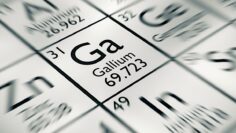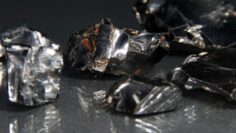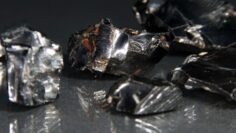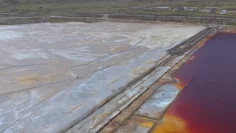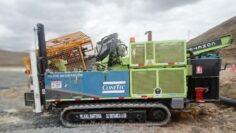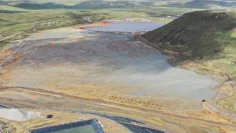{kanada_flagge} After four years of painstaking persuasion, remediation specialist Cerro de Pasco Resources (CSE: CDPR; FRA: N8HP) has reached its goal: the company has obtained all the necessary permits to explore the Quiulacocha tailings pond near the infamous Cerro de Pasco non-ferrous metal mine in Peru for its mineable metal tailings.
These permits also signal the start of commercial exploitation and a cleanup of more than 100 years of mining tailings that have accumulated there. Cerro de Pasco plans to begin drilling in the third quarter.
As of today, CDPR has received the following licenses and permits for its Quiulacocha Tailings Project: The Social License granted by the Rural Municipality of Quiulacocha (Comunidad Campesina de Quiulacocha, “CCQ”) in October 2019; An Environmental Impact Statement (Declaración de Impacto Ambiental, “DIA”) for the Quiulacocha tailings exploration project approved by the Peruvian Ministry of Energy and Mines (“MINEM”) in August 2021; and Technical Approval by the National Water Agency (“ANA”) granted in July 2021. Following several meetings with government representatives, Cerro de Pasco submitted all official documentation required to commence the proposed sonic drilling campaign on May 23, 2022, with the approval of the Peruvian Minister of Mines.
Guy Goulet, CEO of Cerro de Pasco, commented, “We have come a long way to achieve this crucial result. The window is now open to complete our sonic drilling program in the Quiulacocha waste area of our El Metalurgista concession during the current dry season. We will then devote our energy and skill to the development of this significant resource, with the support of the local community and national authorities.”
Steven Zadka, Executive Chairman of CDPR thanked: “On behalf of CDPR, I would like to thank the Peruvian government and its institutions for their support and commitment. They recognize the social and environmental benefits of our project and have demonstrated that they fully support private sector innovation, initiatives and investment hand-in-hand with the public sector. This will be the first large-scale private sector initiative of its kind in Peru, aimed at the responsible reprocessing and remediation of mineral waste. It will bring numerous benefits to the Peruvian state, including significant savings in remediation procedures.”
The Quiulacocha tailings
The Quiulacocha tailings pile (4,300 m a.s.l.) covers an area of approximately 115 hectares, where tailings were stored at the Quiulacocha Tailings Storage Facility (TSF) from the early 1920s until 1992. The tailings stored at the TSF, which are composed of processing residues, originated from the Cerro de Pasco open pit and underground mine. The main period of tailings deposition at Quiulacocha began after 1943, when the Paragsha plant was commissioned, initially processing Cu ore and later Zn-Pb-Ag ore. Historical records indicate that between 1952 and 1992, the Cerro de Pasco mine processed approximately 58.3 million tonnes of Zn-Pb-Ag ore from open pit and underground operations at average grades of 8.6% Zn, 3.3% Pb and 98 g/t Ag.
The most recent historical mineral resource estimate for the Quiulacocha waste rock dumps by BO Consulting in 2012 reported 2.9 Mt at 1.43% Zn, 0.79% Pb, 43.1 g/t Ag and 0.04% Cu. This estimate was based on a near-surface auger sampling program estimated to represent only 4% of the expected tonnes from the deposit.
This historical resource estimate is described and discussed in detail in the technical report entitled “The Excelsior Mineral Pile (EMP) and Quiulacocha Tailings (QT) associated with the Cerro de Pasco Mine, Cerro de Pasco District, Altiplano Region, North-Central Peru” (posted on Sedar.com on July 26, 2018). The information is treated by CDPR as historical information and is not verified for economic evaluation. They are considered historical mineral resources and meet the standards of National Instrument 43-101 of the Canadian Securities Administrators. A qualified person (as defined by NI 43-101) has not performed sufficient work to classify the historical estimate as current mineral resources or mineral reserves. The explanation is that the Qualified Person was not able to fully verify the data obtained through the various historical drilling campaigns and other sampling. Further drilling would be required to improve or verify the historical resources. However, the Qualified Person has read the historical mineral resource assessment documents and believes that they need to be updated to fully comply with NI 43-101 or CIM standards.
Sonic Drilling Program
Sonic drilling involves the generation of high-frequency resonant energy in a sonic head to drive a core barrel and casing into subsurface formations. It is an optimal method when near 100% core recovery from soft, unconsolidated material is desired, using state-of-the-art technology, with no contamination, no water consumption, no earth movement, and no environmental or social impact.
The exploration program is planned for the third quarter of 2022 and will focus on the central, deeper section of the tailings pile. Exploration is planned on a 100 x 100 meter grid, with depth limited by the base of the deposit (lake sediments and organic material). Once the sampling and assaying program and mineralogical studies are completed, composite materials will be prepared to conduct metallurgical studies.
About Cerro de Pasco Resources Inc.
Cerro de Pasco Resources Inc. specializes in remediation of contaminated sites and was founded in 2012 with the objective of developing the El Metalurgista mining concession, which includes tailings and waste rock piles from the Cerro de Pasco open pit mine in central Peru. The company aims to combine long-term economic sustainability with benefits for the local community in economic, social and health terms. The company’s approach at El Metalurgista includes the reprocessing and environmental remediation of mining waste and the creation of numerous opportunities in a circular economy.
Summary: There are more than 7,000 environmental liabilities from mining in Peru, of which more than 180 are classified as extremely risky, according to the General Control of the Republic (Contraloria General de la Republica, 2021). Cerro de Pasco is the largest and certainly the most notorious of these contaminated sites. Removing contaminated sites costs money that the Peruvian state does not have. The solution is a partnership between the state and companies that allows companies like CDPR to make money to fund the cleanup. The first step now is 43-101 compliant identification of the existing resource. Everything can happen very quickly now: Drilling the tailings pond should take only weeks – 40 drill holes of 40 meters each should be enough. In the best case scenario, CDPR will be able to announce a significant resource before the end of the year. Either the way, a reassessment would actually be due. Either way, today’s announcement marks a decisive milestone for all CDPR shareholders. But probably also for the residents of Cerro de Pasco the news is a reason for joy.
Jetzt den GOLDINVEST-Newsletter abonnieren
Folgen Sie uns auch auf Youtube
Disclaimer: The contents of www.goldinvest.de and all other used information platforms of the GOLDINVEST Consulting GmbH serve exclusively the information of the readers and do not represent any kind of call to action. Neither explicitly nor implicitly they are to be understood as an assurance of possible price developments. Furthermore, they do not in any way replace individual expert investment advice, but rather represent advertising / journalistic texts. Readers who make investment decisions or carry out transactions on the basis of the information provided here do so entirely at their own risk. The acquisition of securities involves high risks, which can lead to the total loss of the invested capital. The GOLDINVEST Consulting GmbH and its authors expressly exclude any liability for financial losses or the content guarantee for topicality, correctness, adequacy and completeness of the articles offered here. Please also note our terms of use.
According to §34 WpHG we would like to point out that partners, authors and/or employees of GOLDINVEST Consulting GmbH may hold or hold shares of the mentioned companies and therefore a conflict of interest may exist. Furthermore, we cannot exclude that other stock exchange letters, media or research firms discuss the stocks we discuss during the same period. Therefore, symmetrical information and opinion generation may occur during this period. Furthermore, between the mentioned companies and GOLDINVEST Consulting GmbH directly or indirectly a consulting or other service contract may exist, which may also cause a conflict of interest.



